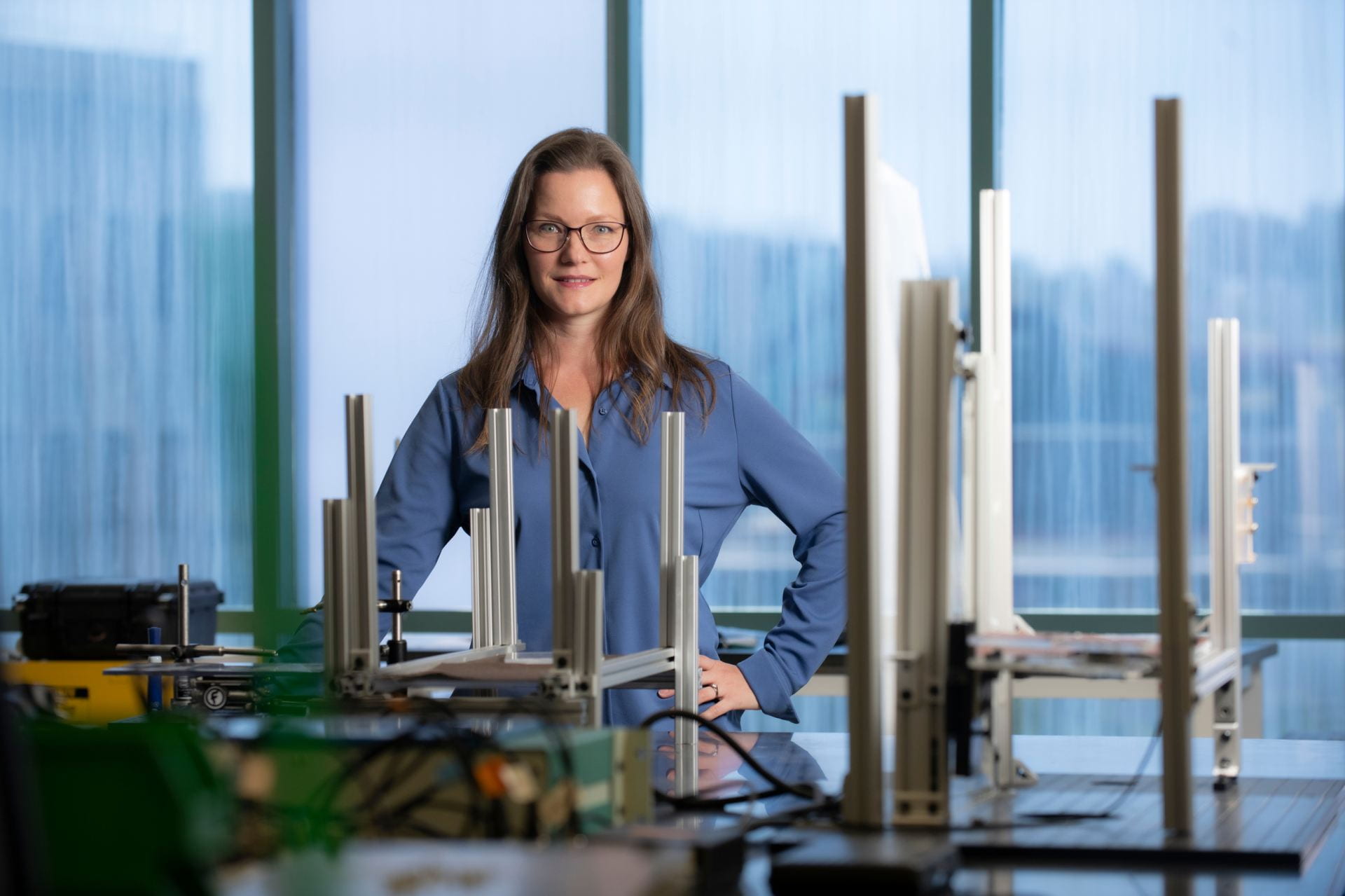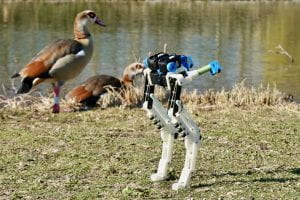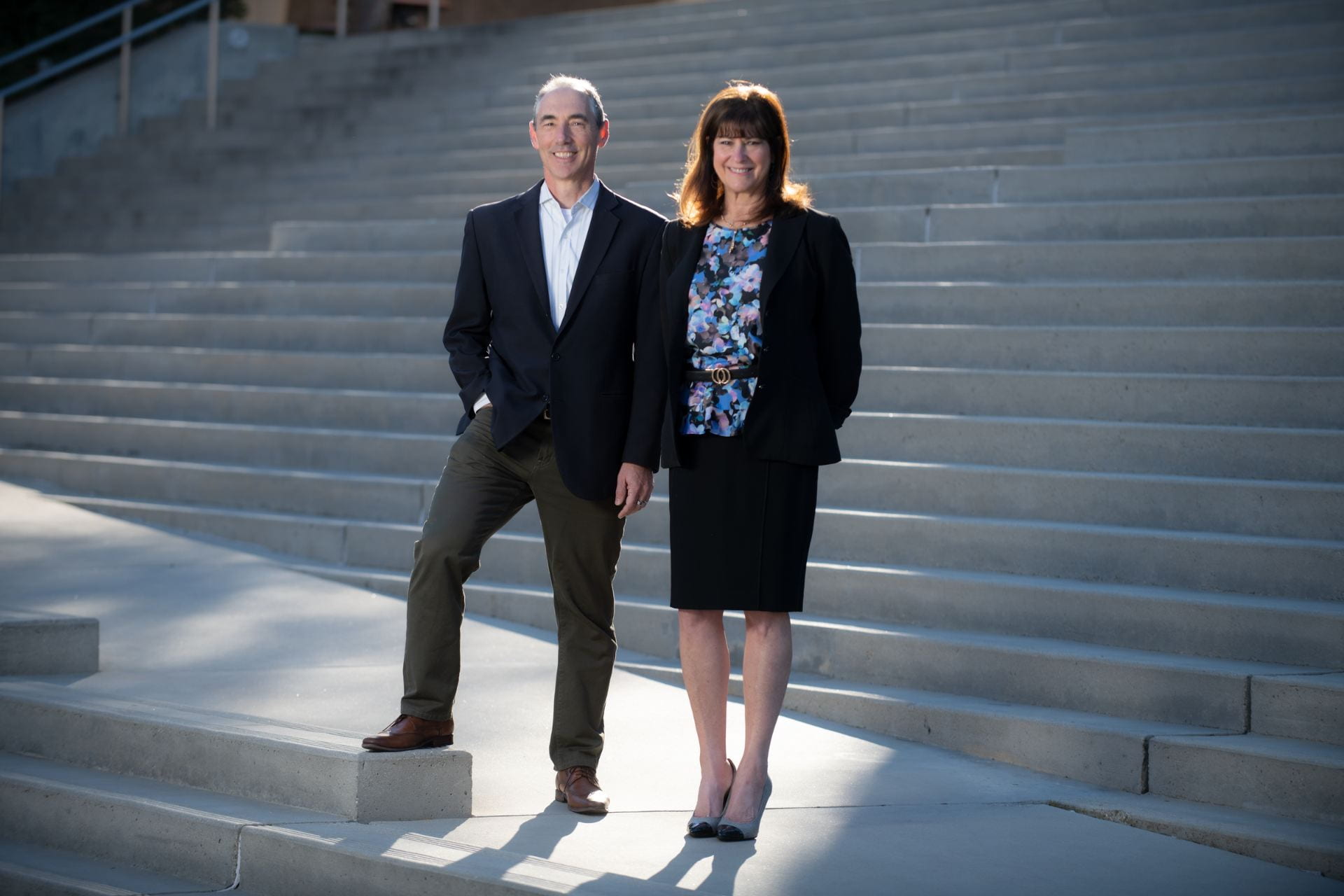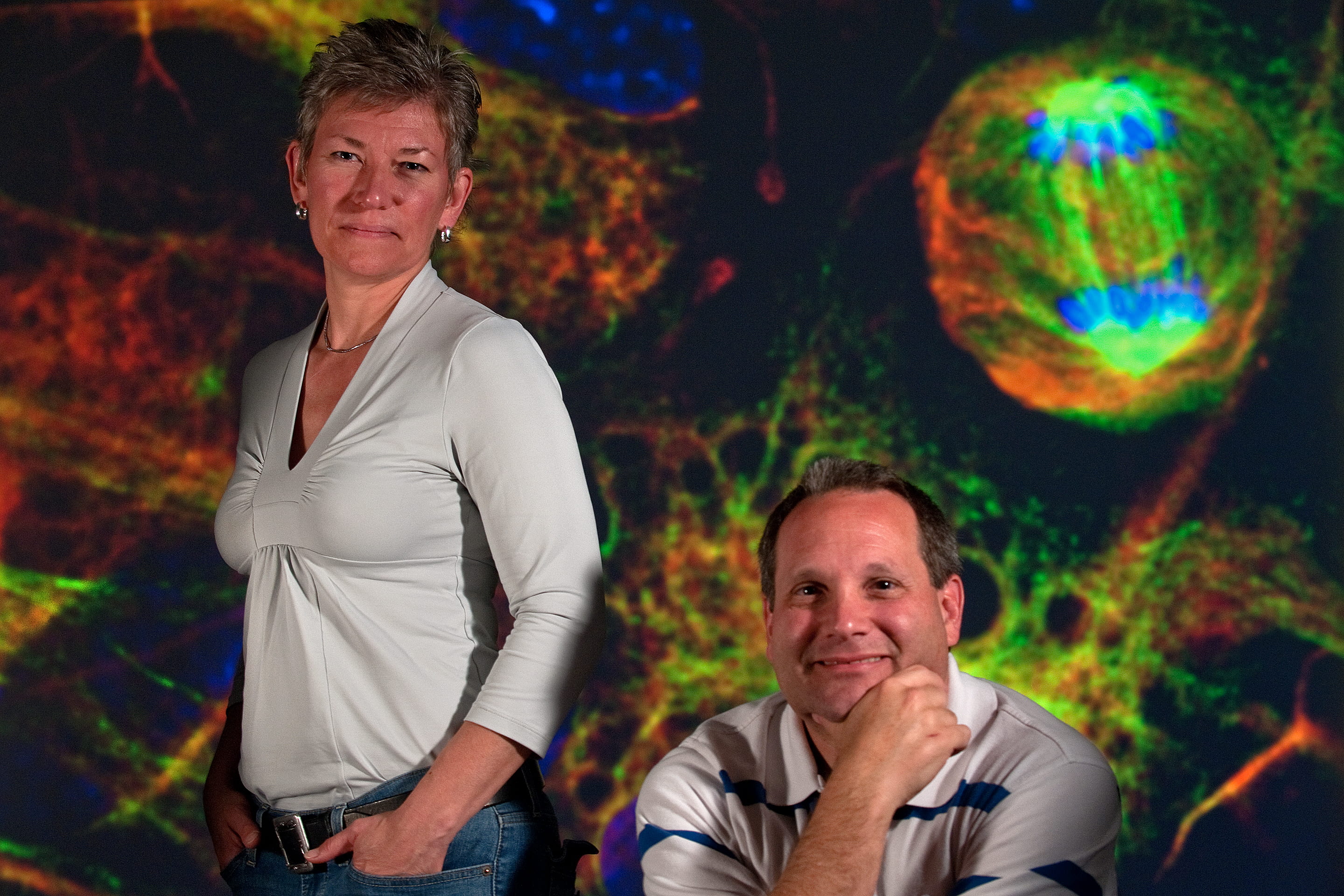A bird's leg view
Monica Daley studies avian ground movement to help people with mobility issues

Monica Daley’s research literally has a leg up on the competition – so long as that leg is attached to turkeys, ostriches, pheasants, bobwhite quail, secretary birds or, most recently, guinea fowl.
The UCI associate professor of ecology and evolutionary biology studies how birds traverse the ground so that better leg prosthetics and treatments for movement disorders can be devised for humans. To those ends, Daley studies people too. She directs the Center for Integrative Movement Sciences, which includes all disciplines of movement sciences, and its new Human Performance Lab, which focuses on human movement sciences. These encompass comparative and human basic biology research as well as applications in human rehabilitation, well-being, exercise sciences, and engineering technologies for mobility assistance and activity monitoring.
As the senior author of “BirdBot achieves energy-efficient gait with minimal control using avian-inspired leg clutching,” which the journal Science Robotics published on March 16, Daley was part of an international team of researchers who demonstrated a novel approach to bipedal robotic locomotion with a robot based on a bird.

While many robots utilize human-inspired mechanisms for bipedal locomotion, the bipedal movement of birds – with a track record going back hundreds of millions of years by way of evolving from theropod dinosaurs – might prove to be a better, more effective form of locomotion for the machines. The research robot’s bird-inspired leg mechanisms showed that bots designed in this fashion could achieve stable and economical movement with significantly less sensory information than required in other legged robotic designs.
Daley was interviewed recently about her research.
Why is knowing how animals move important?
Locomotor behaviors are essential for daily living for almost every animal. Locomotor performance is a huge factor in natural selection and the evolution of diversity among animals. If you look at any given animal, a lot of its features, such as size and shape, relate to its locomotor behavior and locomotor ecology. Understanding how animals move and why they move in the way they do under different circumstances is essential for understanding the evolution of diversity among organisms. Understanding locomotor behavior and physiology also helps us understand how animals might respond to changes, such as in climate or environmental conditions. That’s becoming increasingly important, as our landscapes in California are dramatically changing with wildfires and drought.
Is it correct that while the gaits of birds and humans are different, studying birds’ gaits can ultimately help in the treatment of humans with movement disorders?
Yes. There are some features that are remarkably similar, and we can think about the similarities and differences at different organizational levels. At one level, there’s your whole-body movement pattern – how your body moves up and down during the gait cycle, how you’re oscillating your legs, the sequence of steps and things like that. These features are very similar between people and birds. Like humans, birds walk at slow speeds and run at high speeds. The motions of the body and the force that the legs exert against the ground are remarkably similar. What’s different is our leg architecture and evolutionary history.
Birds are interesting because they have a long legacy of bipedal locomotion. There’s a lot of diversity in body size and habitats birds move through. We can use that diversity to get insights into general principles: which features hold across all these animals and which are specific to large body size or small body size and so on. An interesting contrast between birds and humans is that the specific morphology of birds enables a lot more intrinsic mechanical control – bird locomotion doesn’t need to be actively controlled by the nervous system with rapid reflex responses to the same degree as human locomotion. And there are advantages to this. Many individuals who have lost function in their lower leg because of peripheral neuropathy or amputation, or who have had a stroke and must undergo progressive physical therapy to rehabilitate movement, don’t have the same sensing of the interaction with the ground through their leg. In these cases, we could design prosthetics and exoskeletons inspired by birds to get effective function with minimal control.
Why are guinea fowl your main study animals?
They’re small ground birds but large enough to be a convenient size for study (about the size of a chicken). Guinea fowl exhibit similar gaits and locomotor strategies as humans. Smaller animals than guinea fowl tend to have very crouched postures, and their locomotion comes in bursts. They tend to accelerate and decelerate, to run from one shrub to another shrub to hide. So they’re not moving at a steady pace a lot of the time. Guinea fowl are known to travel more than 15 miles per day while foraging.
What are some other birds you have studied?
Besides guinea fowl, other live animals we have had in the lab are bobwhite quail, pheasants, turkeys and ostriches. Ostriches get a lot of attention, but I wouldn’t recommend them as a lab animal. They’re charismatic but very expensive to keep. You need a lot of space, and they’re dangerous to handle, of course.
We’ve also tried to branch out a little by collaborating with zoos and wildlife parks. I had one study measuring the kicking strikes of the secretary bird. This was a unique opportunity because there was a secretary bird named Madeline at the Hawk Conservancy Trust in the U.K. that had been trained to strike snakes on demand. So we could measure the ground forces and high-speed motion to understand how the secretary bird achieves effective killing strikes without getting bitten by snakes. Unfortunately, Madeline passed away last week of old age. Although it’s very sad, she had a long and accomplished life.
In the future, I’m hoping to study more diverse species. Going out into the field is an important area for further development because it can allow us to understand how animals move through natural environments.
Is there a specific animal you have not studied yet that you would like to?
I’d love to study roadrunners. They fly in very short bursts, similar to guinea fowl, and they’re agile runners that mostly move over ground.
I have a new study in collaboration with a colleague at USC, Craig McGowan [associate professor of clinical integrative anatomical sciences], and we’re looking at kangaroo rat locomotor behavior. It’s a hopping rodent that uses dramatic jumping performances to escape predators. We’re interested in how kangaroo rat locomotor behaviors vary in different environmental conditions and in the presence of different risks in their environment, such as predators or competitors for food resources.
And you have a new Human Performance Lab at the Center for Integrative Movement Sciences.
Yes. There are some advantages to doing studies with humans because you can ask humans to do a specific task. You have the opportunity for more controlled experiments to investigate the mechanisms of movement and control in ways that you can’t do with animals. We can’t ask animals to do specific tasks, like run as fast as possible or run around a bend. Instead, we must create specific conditions for the animals by manipulating their environment and then hope they do the task we’re interested in. Often, animals respond to our experiments in unexpected ways, and this can be challenging – but also a source of discovery.
What initially prompted you to get into this research?
I was a biology major at the University of Utah. I’m a first-generation college student, and I knew nothing about academia. I didn’t know anybody with a Ph.D., so I didn’t really know whether being a professor was a plausible path for me or even a desirable one. So when I went to university, I was initially pre-med. Then I thought, because I do like animals a lot, that maybe I’d switch to pre-vet and go into veterinary medicine. I knew I really liked complex biology and trying to solve biological puzzles. I did very well in my genetics class, and I enjoyed thinking about it, but for me, genetics weren’t as exciting or rewarding as biomechanics because it was difficult to see the science.
Honestly, it was inspiration from my professors when I was an undergraduate that steered me toward this research. I took a class in animal biology at the University of Utah, and my professors were David Carrier [professor of biological sciences] and Dennis Bramble [professor emeritus of biology]. I think I was a sophomore, and they taught about how you can use engineering principles to understand function in animals. And I would just be like, “Wow, that’s so cool.” You can use these very simple Newtonian mechanics and materials science principles from engineering and get a lot of insight into form, function and diversity in animal movement. I was so inspired by that class that I went to those professors to see if I could do undergraduate research, and that’s how I got started.
You said you thought about veterinary medicine, and I understand that before coming to UCI, you were on the faculty at London’s Royal Veterinary College.
Yes, I taught vet students at the Camden campus for 12 years, and my research lab was at the Hawkshead campus. The Royal Veterinary College is a small school, but it has long been a center of excellence for animal locomotor biomechanics. I did my Ph.D. at Harvard University, then was a postdoc in human kinesiology at the University of Michigan. In the second year of my postdoc, a faculty position opened at the Royal Vet College in comparative biomechanics, and the opportunity and resources there aligned well with what I wanted to study at the time: comparative locomotion across a large size range in birds. Out at the Hawkshead campus, they had space to keep a large flock of ostriches, and at the Camden campus, it was possible to recruit students with a keen interest in working with exotic animals.
My interests have since shifted more toward understanding sensorimotor control [the regulation of sensory and motor pathways to produce movement], and that’s why I’m now focused more on guinea fowl as my animal model – and translation to human movement.
In what specific ways has UCI helped you conduct your research?
I’ve been here a relatively short period of time – going on three years – and I’ve had a fantastic opportunity in that the dean of the School of Biological Sciences had already supported the construction of the new human movement performance lab. And there’s an outstanding group of physiology faculty in the Department of Ecology and Evolutionary Biology that have a longstanding history in the field. Having those close collaborators, who built a center of excellence in the department, means that I have outstanding support as a faculty member in this group. It’s truly an honor to be a part of it.
I received startup funding to renovate the lab that houses the guinea fowl for neurophysiology experiments and then also to equip the new Human Performance Lab. I had one-year pilot funding from the National Science Foundation to start the Center for Integrative Movement Sciences. After our initial year of running CIMS, the vice provost for research provided a lot of support to develop a strong grant proposal to form an ongoing center through the NSF Biology Integration Institutes program, which would be for $12.5 million over five years. This proposal is still in review through the NSF Division of Biological Infrastructure.
Have you seen any sparks ignite among your students?
I’ve had a lot of enthusiastic undergraduates, and it’s been great working with the undergraduate researchers here. We funded 37 trainees to do collaborative movement sciences research. In fact, we’ve had lots of truly great research projects come out of this program. Several students submitted conference abstracts and applied to graduate school after this program, and I’m co-authoring a paper with undergraduates who started through our summer program. There are many students in biological sciences who are interested in going into health professions, and many of them can see the relevance of this research to their current career development and future professional goals.
If you want to learn more about supporting this or other activities at UCI, please visit the Brilliant Future website at https://brilliantfuture.uci.edu. Publicly launched on Oct. 4, 2019, the Brilliant Future campaign aims to raise awareness and support for UCI. By engaging 75,000 alumni and garnering $2 billion in philanthropic investment, UCI seeks to reach new heights of excellence in student success, health and wellness, research and more. The School of Biological Sciences plays a vital role in the success of the campaign. Learn more by visiting https://brilliantfuture.uci.edu/school-of-biological-sciences.


